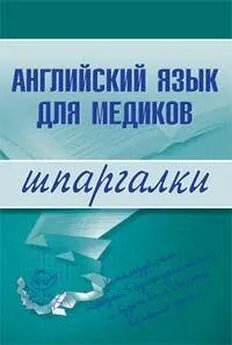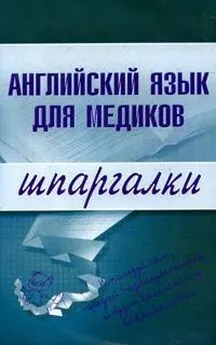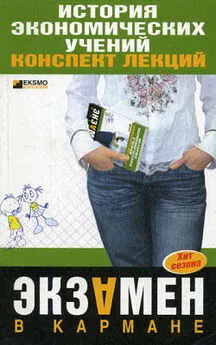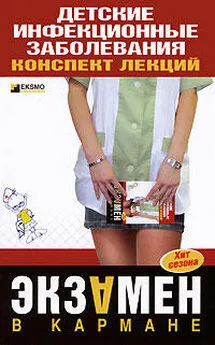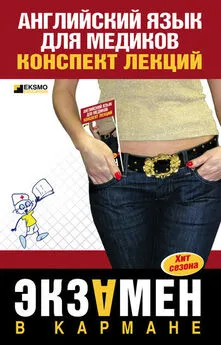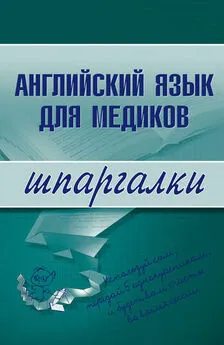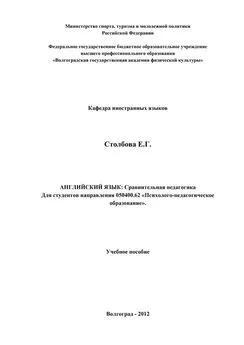Елена Беликова - Английский язык для медиков: конспект лекций
- Название:Английский язык для медиков: конспект лекций
- Автор:
- Жанр:
- Издательство:Конспекты, шпаргалки, учебники «ЭКСМО»b4455b31-6e46-102c-b0cc-edc40df1930e
- Год:2007
- Город:Москва
- ISBN:978-5-699-20181-5
- Рейтинг:
- Избранное:Добавить в избранное
-
Отзывы:
-
Ваша оценка:
Елена Беликова - Английский язык для медиков: конспект лекций краткое содержание
Представленный вашему вниманию конспект лекций предназначен для подготовки студентов медицинских вузов к сдаче экзамена. Книга включает в себя полный курс лекций по английскому языку, написана доступным языком и будет незаменимым помощником для тех, кто желает быстро подготовиться к экзамену и успешно его сдать.
Английский язык для медиков: конспект лекций - читать онлайн бесплатно ознакомительный отрывок
Интервал:
Закладка:
Metanephros: During the fifth week, the metanephros, or permanent kidney, develops from two sources: the ureteric bud, a diverti-culum of the mesonephric duct, and the metanephric mas, from intermediate mesoderrn of the lumbar and sacral regions. The ureteric bud penetrates the metanephric mass, which cordenses around the diverti-culum to form the metanephrogen cap. The bud dilates to form the renal pelvis, which subsequently splits into the cranial and caudal major calyces. Each major calyx buds into the metanephric tissue to form the minor calyces. One-to-three million collecting tubules develop from the minor calyces, thus forming the renal pyramids. Penetration of collecting tubules into the metanephric mass induces cells of the tissue cap to form nephrons, or excretory units. The proximal nephron forms Bowman's capsule, wherea the distal nephron connects to a collecting tubule.
Lengtheningy of the excretory tubule gives rise to the proximal convoluted tubule, loop of Henle, and the distal convoluted tubule.
The kidneys develop in the pelvis but appear to «ascend» into the abdomen as a result of fetal growth of the lumbar and sacral regions. With their ascent, the ureters elongate, and the kidneys become vascu-larized by lateral splanchnic arteries, which arise from the abdominal aorta.
Bladder and urethra
Adrenal glands lie The proximal nephron forms above the kidneys and are of dual origin. The cortex develops from the mesoderm of the coelomic epithelium, and the medulla is derived from neural crest cells, which migrate to the area and differentiate to form catecholami-ne-producing cells. Urorectal septum divides the cloaca into the ano-rectal canal and urogenital sinus by the seventh week.
The upper and largest part of the urogenital sinus becomes the urinary bladder, which is initially continuous with the allantois. As the lumen of the allantois becomes obliterated, a fibrous cord, the urachus, connects the apex of the bladder to the umbilicus. In the adult, this structure becomes the median umbilical ligament. The mucosa of the trigone of the bladder is formed by the incorporation of the caudal me-sonephric ducts into the dorsal bladder wall. This mesodermal tissue is eventually replaced by endodermal epithelium so that the entire lining of the blad der is of endodermal origin. The smooth muscle of the bladder is derived from splanchnic mesoderm.
Mile urethra is anatomically divided into three portions: prostatic membranous, and spongy (penile).
The prostatic urethra, membranous urethra, and proximal penile urethra develop from the narrow portion of the uro genital sinus below the urinary bladder. The distal spongy urethra is derived from the ectodermal cells of the glans penis.
Fimale urethra: The upper two-thirds develops from the esonephric ducts, and the lower portion is derived from the ogenital sinus.
The urinary system is the major system involved in the excre tion of metabolic waste products and excess water from the body. It is also important in maintaining a homeostatic bal ance of fluids and electrolytes. The urinary system consists of two kidneys, two ureters, the urinary bladder, and the ure thra. Urine is produced by the kidneys and is then transmit ted via the ureters to the bladder for temporary storage. The urethra is the final pathway that conveys urine to the exteri or. This system also has an important endocrine function in the production of renin and erythropoietin, which influence blood pressure and red blood cell (RBC) formation, respec tively.
New words
urinary system – мочевая система
consisting of – состоящий из
kidneys – почки
bladder – мочевой пузырь
excretory ducts – выделительные трубочки
mesodermal – мезодермальный
endodermal – эндодермальный
derivatives – производные
con tribution – вклад
sequentially – последовательно
pronephros – первичная почка
vestigial – остаточный
transiently – скоротечно
definitive – категорический
permanent – постоянный
duct – трубочка
bud – зародыш
to dilates – расширять
urogenital – мочеполовой
cloaca – клоака
anorectal canal – канал анаректальный
waste products – ненужные продукты
maintaining – поддержание
a homeostatic balance – гомеостатический баланс
fluids – жидкости
electrolytes – электролиты
Раскройте скобки, употребляя глаголы в Past Simple, Past Continuous и Past Perfect.
1. When I called at his house, they (to tell) me that he (to leave) an hours before.
2. When I came to the station, I (not to) find my friend there as I (to be) five minutes late and the train (to leave).
3. He (to want) to visit the place where he (to live) in his childhood.
4. The telegram (to come) some minutes after he (to leave).
5. She (to look) very tired as she (to work) hard.
6. I (to return) to the hotel only late at night as I (to lose) my way in the fog. When I (to come) up to my room, I (to see) Pete who (to stand) at the door of the room. He (to wait) for me as he (to lose) his key and could not get in.
7. When I (to wake) up, it (to be) already ten o'clock. I (to call) my brother. Nobody (to answer). He already (to leave).
8. I (to go) up to the open window. The rain (to stop) and the sun (to shine) brightly. The birds in the garden (to sing). The morning (to be) fine.
9. When the rain (to stop) I (to look) out of the window and (to see) John who (to stand) under a tree waiting for me.
10. Last night we (to go) to a football match.
11. We (to take) a bus. The bus (to be) full, of people as many people (to want) to see the match.
12. We (to get) off the bus and (to go) in the direction of the stadium.
13. While we (to cross) the road, I (to see) Victor.
14. He (to stand) at the corner.
15. He said he (to wait) for his friend who (to come) to St. Petersburg the day before and (to wish) to see the new stadium.
16. A man (to come) up to me and asked if I (to have) a spare ticket for-the match.
17. Victor told us that two boys just (to ask) him whether he (to have) a spare ticket.
18. We (to enter) the stadium just as the foot ball players (to come) out on to the field.
19. At the entrance to the stadium we (to meet) Sergei.
20. He (to show) us to our seats and we (to agree) to meet in the refreshment-room during the interval. He (to ask) me if I (to play) football in my childhood.
Раскройте скобки, употребляя глаголы в Past Simple, Past Continuous и Past Perfect.
1. I (to sit) in an armchair and (to think) of my coming trip across the North Sea when the door suddenly (to open) and an old friend of mine whom I (not to see) for a very long time (to enter) the room.
2. She (to come) to see us just at the time when we (to have) dinner. It (to be) the first time I (to see) her.
3. I (to see) him just as he (to leave) the hotel.
4. I (not to see) him before we (to meet) at the concert.
5. He (to leave) the house before 1 (to have) time to ask him anything.
6. He (to tell) me he (to learn) it from the newspaper.
7. He (to enter) the room, (to take) something from the desk and (to go) out.
8. There (to be) two men in the room. One of them (to write) something while the other (to read) a newspaper.
9. He (not to tell) me that he (to receive) a telegram from her.
10. I (to ask) him if he (to know) where she (to live). I (to say) I (not to know) her address.
11. He (to ask) me if I (can) give him your address.
12. She (to say) that he (to give) her the wrong address.
13. I (to ask) him where he (to put) my letter.
14. He (to tell) us that they (to spend) all the money.
15. After spending several days in Paris he (to feel) lonely and (to want) to return home.
16. I (to think) he already (to go) home.
17. I (to find) the old man in the garden. He (to talk) to some chil dren who (to stand) around listening to him.
18. He (to speak) a language we never (to hear) before.
19. Yesterday I (to look) at the sky for an hour.
20. Mandy (to read) a book the whole evening.
Answer the questions.
1. What is the urinary system consists of?
2. How many separate systems form sequentially?
3. Is the pronephros vestigial?
4. How may mesonephros function?
5. How does metanephros develop?
6. How is the renal development characterized?
7. Where does the ureteric bud penetrate?
8. What does the proximal nephron form?
9. Where do the adrenal glands lie?
10. Into how many portions is the mile urethra anatomically divided?
Make the sentences of your own using the new words (10 sentences).
Find the Present Simple in the text. Explain why it is used in such a way?
Find one word, which is a little bit different in meaning from others (найдите одно слово, которое немного отличается от других по смыслу):
1) a) kidney; b) head; c) urethra;
2) a) teeth; b) bladder; c) parenchyma;
3) a) cloaca; b) urogenital; c) nasal;
4) a) neck; b) pronephros; c) kidney;
5) a) liquid; b) cell; c) blood.
ЛЕКЦИЯ № 44. Kidneys
The kidneys are retroperitoneal organs that remove urea and other waste products from the blood. In addition, they regu late the chemical composition of plasma and the extracellular fluid of the body. Each kidney is composed of stroma and parenchyma. The stroma consists of a tough fibrous connective tissue capsule and a delicate interstitial connective tissue com posed of fibroblasts, wandering cells, collagen fibrils, and a hydrated proteoglycan extracellular matrix, which is collec tively called the renal interstitium. The parenchyma consists of more than one million elabo rate uriniferous tubules that represent the functional units of the kidney.
The kidney contains a hilum, a cortex, and a medula. The hilum is located medially and serves entrance as the point of entrance and exit for the renal artery, renal veins, and ureter. The renal pelvis, the expanded upper, divides into two or three entrance into the kidney. These, in turn, divide into eight minor calyces. Branches of the renal artery, vein, and nerve supply each part of the kidney.
The cortex forms the outer zone of the kidney, as well as several renal columns, which penetrate the kidney.
The medulla appears as a series of medullary pyramids. The tips of the pyramids point toward the at the hilus. The apex of each pyramid stream into a minor calyx. Two or three pyramids may unite to form a papilla. Uriniferous tubules consist of two functionally related portions called the nephron and the collecting tubule.
Urinoferous tubules consist of two functionally related portions called the nephron and collecting tubule.
Glomerulus is made up of several anastomotic capillary loops interposed between an afferent and an efferent arteriole. The endothelium of the glomerulus is thin and fenestrated. Plasma filtration (ultrafiltra-tion) occurs in the glomerulus.
Bowman's capsule consists of an inner visceral layer and an outer parietal layer. The space between these layers, the uri nary space, is continuous with the renal tubule.
Читать дальшеИнтервал:
Закладка:

